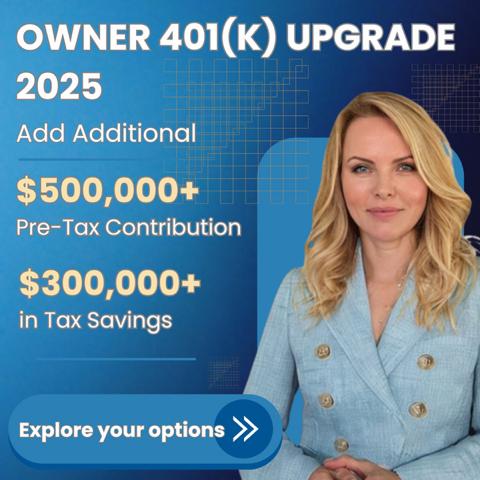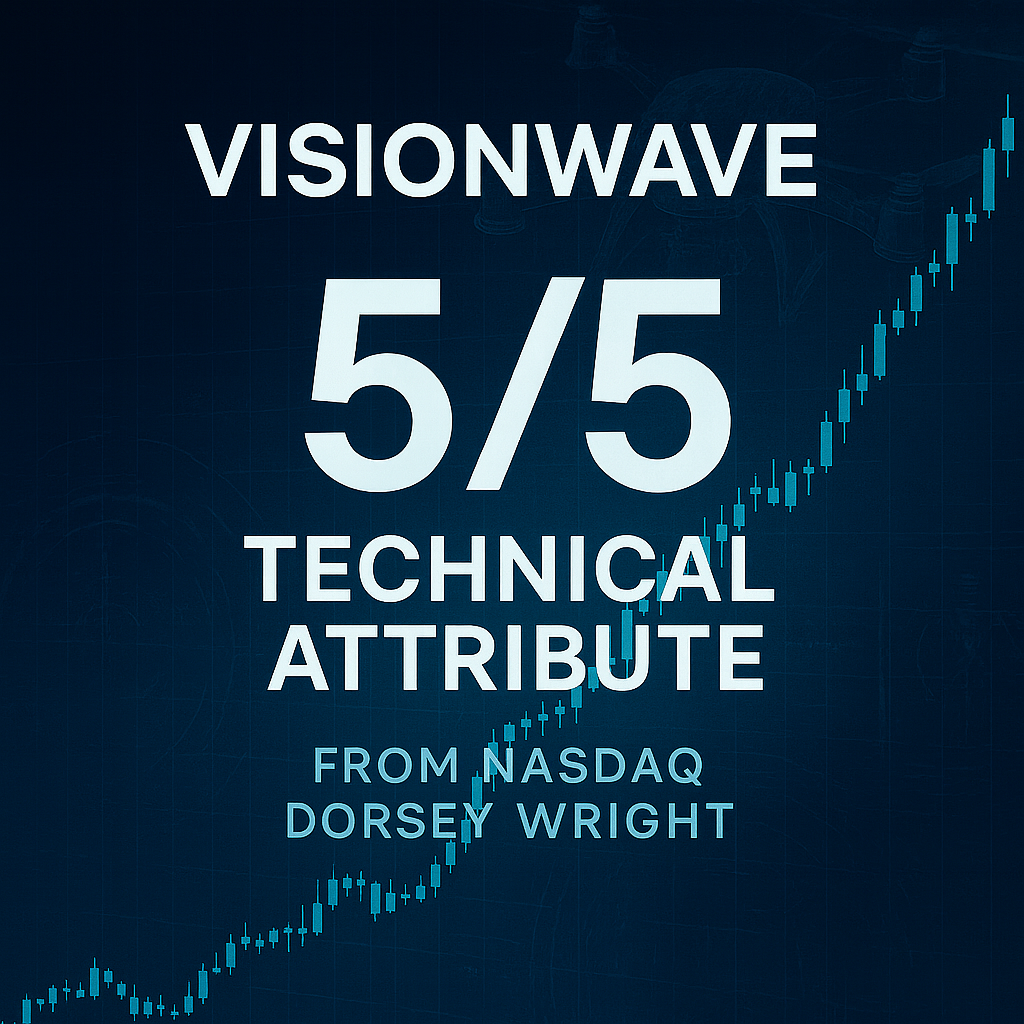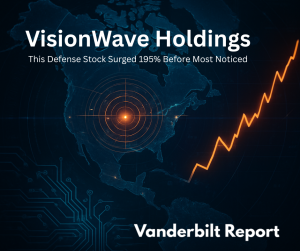Vanderbilt Report: Market Momentum Confirmed — VisionWave Receives Perfect 5/5 Technical Attribute from Nasdaq Dorsey Wright
Momentum doesn’t lie. It leaves tracks in price action, volume patterns, and institutional flow.
VisionWave Holdings (Nasdaq: VWAV) just received a Technical Attribute Score of 5/5 from Nasdaq Dorsey Wright—a perfect rating that represents the highest level of relative-strength leadership. That’s not a press release metric. It’s a systematic signal that quantitative funds and momentum algorithms actually track.
The score arrived weeks after VisionWave’s inclusion in the S&P Total Market Index, one of the broadest equity benchmarks covering major U.S. companies. Together, these validations create something most emerging defense-tech stocks never achieve: dual institutional visibility at the peak technical tier.
What a Perfect Technical Score Actually Measures
The Nasdaq Dorsey Wright system ranks stocks 0-5 based on relative strength versus the S&P 500 and sector peers. Over multiple decades, high-scoring stocks have been proven to outperform lower-ranking counterparts.
A 5/5 rating represents absolute technical leadership—the highest possible designation. It means VisionWave has outperformed nearly all comparable companies on a risk-adjusted basis, demonstrating not just sustained positive performance but exceptional accumulation by market participants.
This is rare territory for any stock, and especially uncommon for a newly listed defense-technology issuer. The methodology identifies stocks exhibiting the strongest leadership characteristics that technical investors view as premium buyable opportunities with significant continued momentum potential.
For VisionWave, the perfect score confirms what price action has been screaming: systematic buying pressure exists at institutional scale.
Index Inclusion Creates Mechanical Demand
Most investors recognize index inclusion as validation. Fewer understand the operational cascade it triggers.
When a company enters the S&P Total Market Index, it becomes eligible for passive fund replication. Index-tracking ETFs and mutual funds must purchase shares to maintain benchmark alignment. That creates baseline demand independent of fundamental opinions.
Beyond passive flows, index inclusion raises visibility to systematic and momentum-driven capital. Quantitative models screening for technical strength now encounter VisionWave in their eligible universe—and with a perfect 5/5 rating, it appears at the very top of those screens.
The combination matters: a perfect momentum rating plus index presence dramatically increases the probability VisionWave appears on institutional accumulation lists. The stock isn’t just eligible anymore. It’s flagged as priority.
Defense AI Timing Amplifies Visibility
VisionWave operates at the intersection of two accelerating trends: defense modernization and AI autonomy.
The global AI in aerospace and defense market reached $25.43 billion in 2024 and is projected to reach $65.43 billion by 2034, expanding at 9.91% annually. U.S. defense budgets continue allocating substantial resources toward AI-enabled systems, unmanned platforms, and autonomous sensing infrastructure.
VisionWave’s Evolved Intelligence engine focuses on real-time perception and prediction for autonomous systems across air, land, and sea domains. The company recently completed a pilot program with a U.S. tier-1 defense manufacturer, advancing to evaluation sample purchases and joint system integration planning—concrete evidence of defense-grade validation and commercial traction.
Thematic alignment with high-growth sectors increases the likelihood that momentum signals attract attention from sector-focused capital. When a defense-AI stock scores perfectly on technical metrics during a defense-tech upcycle, quantitative models take notice.
The Significance of Perfect Technical Validation
Perfect scores are earned, not given. In the Nasdaq Dorsey Wright system, a 5/5 rating indicates a stock has achieved sustained outperformance across multiple timeframes and momentum factors.
This level of technical strength typically attracts specific types of capital:
Momentum funds that systematically rotate into top-performing stocks based on relative strength. These strategies are designed to ride leadership stocks until technical deterioration signals exit.
Quantitative strategies that screen for technical attributes as primary selection criteria. A perfect score places VisionWave in the top percentile of their screening universes.
Tactical allocation models used by wealth managers and RIAs looking for systematically validated opportunities. Technical leadership provides objective evidence that institutional accumulation is occurring.
Sector rotation models that identify leadership stocks within specific industries. VisionWave now represents peak technical strength within defense-tech.
The rating doesn’t guarantee future performance, but it does confirm current institutional interest and validates that market structure is supportive of continued momentum.
The Three-Phase Progression Model
Market recognition for emerging defense-tech companies typically follows a progression:
Phase I is story establishment. The company articulates positioning, announces partnerships, and begins demonstrating technical capability. VisionWave executed this through its Nasdaq debut, pilot program completion, and strategic collaboration announcements.
Phase II is market recognition. Technical strength emerges, index inclusion occurs, and institutional algorithms begin flagging the stock. VisionWave has not just entered this phase—it has achieved peak validation within it, earning the highest possible technical rating while gaining index exposure.
Phase III is capital expansion. Liquidity increases, analyst coverage grows, and institutional ownership rises as validation converts to tangible capital inflows. The perfect technical score and index inclusion position VisionWave at the threshold of this phase.
Progression through these phases depends on continued execution and market conditions.
But the pattern exists. And VisionWave’s dual validation—especially at the perfect 5/5 level—suggests Phase II momentum isn’t just building. It’s established at maximum technical strength.
What This Means Operationally
Technical scores and index inclusion represent market structure changes that enhance visibility and accessibility to institutional capital.
For VisionWave, these validations strengthen capital market credibility at a critical time when defense-tech companies compete for partnerships, contracts, and licensing agreements. Perfect technical leadership signals to potential partners that market participants view the company as top-tier accumulation material, not speculative moonshot.
The convergence of perfect technical strength, index exposure, and thematic relevance indicates VisionWave has entered the market’s awareness loop at the highest possible tier. This creates exceptionally favorable conditions for institutional engagement.
Sustaining this trajectory depends on continued execution discipline and achieving operational milestones. But the foundation is now set: VisionWave is being tracked, ranked, and flagged by the same systems that guide billions in institutional capital allocation.
Why Perfect Scores Attract Attention
In quantitative investing, rankings matter more than narratives. A 5/5 technical rating automatically elevates VisionWave above 80-90% of comparable securities in screening processes.
When portfolio managers review momentum strategies, they look at the top-rated stocks first. When algorithms rebalance based on technical strength, perfect scores receive maximum position weights. When sector analysts scan for leadership stocks, 5/5 ratings stand out immediately.
This isn’t speculative positioning. It’s systematic recognition that the stock has demonstrated measurable, sustained outperformance relative to peers and benchmarks.
For a defense-tech company still in growth phase, achieving perfect technical validation creates a halo effect: it suggests the market has identified something institutional capital wants to own.
The Defense-Tech Context
VisionWave’s perfect rating arrives as defense-tech allocation is accelerating across institutional portfolios. The sector combines government spending stability with AI-driven growth potential—a rare combination that appeals to both growth and defensive allocation strategies.
Companies demonstrating both technical strength and operational progress attract premium attention in this environment. VisionWave’s pilot completion with a tier-1 defense manufacturer provides fundamental validation while the perfect technical score provides market-structure validation.
The dual validation matters because it addresses both sides of institutional decision-making: fundamental research teams want to see execution progress, while quantitative teams want to see technical confirmation. VisionWave now delivers both.
The Validation Window
Systematic technical validation represents a meaningful milestone for emerging companies, moving beyond discovery mode into measurable momentum.
VisionWave hasn’t just crossed into validation territory—it has achieved peak validation. The perfect technical score confirms it. The index inclusion mechanizes it. The defense-AI tailwind contextualizes it.
What happens next depends on whether the company can convert visibility into tangible results: contract wins, revenue growth, partnership expansions, and sustained technical leadership.
The market is watching. The algorithms are tracking. The validation window is open—and VisionWave is entering it with maximum technical momentum
Compliance Note
The Vanderbilt Report is a financial news and analysis platform. The information contained herein is based on publicly available sources, regulatory filings, and company disclosures believed to be accurate at the time of publication. This report is for informational purposes only and should not be construed as investment advice, a solicitation, or an offer to buy or sell any security.
The Vanderbilt Report does not provide investment banking, brokerage, or advisory services, and no compensation related to the analysis or publication has been received from the companies mentioned unless expressly disclosed.
Readers are encouraged to perform their own due diligence and consult a licensed financial advisor before making any investment decisions. All forward-looking statements are subject to risks and uncertainties that may cause actual results to differ materially.












